Finding Space—and Solitude—Where No Man Has Gone Before in an Ever-More Crowded Country and Planet
Published on September 26th, 2015
PDF Download: caps_issues_finding_space_solitude_in_an_ever_more_crowded_world_2015.pdf
By Leon Kolankiewicz, CAPS Senior Writing Fellow
October 2015

Years before I became persona non grata in the Sierra Club for my criticism of its leadership’s refusal to acknowledge immigration’s environmental impacts and my participation in the intra-club insurgency known as SUSPS (Sierrans for U.S. Population Stabilization), I wrote a feature story for the organization’s flagship publication, Sierra.
The July/August 1981 issue of Sierra carried my article, “British Columbia: Canada’s Battleground on the Pacific,” in which I mourned the fact that the pristine forests, rivers and mountains of Canada’s spectacularly beautiful westernmost province were rapidly being converted into wood chips, pulp and paper, hydroelectric kilowatts, mine tailings, and gaping pits. Into eyesores and effluent, in other words.
As an American, just what qualified me to weigh in on pressing environmental issues in a Canadian province? Well, I had just finished four years as a graduate student at the University of British Columbia’s School of Community and Regional Planning (SCARP). Among other distinctions, SCARP gave birth to Ecological Footprint analysis, conceived originally by my brilliant and groundbreaking M.S. thesis advisor, Prof. William E. Rees, Ph.D.
Yankee or not, I had thoroughly immersed myself in B.C.’s environmental and conservation politics, especially wilderness and wildlife preservation. I had also written my Master’s thesis on pollution control in the Fraser River, Western Canada’s most important river for Pacific salmon.
Anyway, at one point in my Sierra article, I invoked the iconic American conservationist, Aldo Leopold, who had remarked in his 1949 conservation classic, A Sand County Almanac, that:
“In Canada and Alaska, there are still large expanses of virgin country, Where nameless men by nameless rivers wander, and in strange valleys die strange deaths alone.”
But nowadays, I went on to lament:
“…in the Northwest, there are no more nameless rivers, and most of the remaining strange valleys will soon be logged, dammed, mined or opened to rugged individualists in jeeps and campers.”
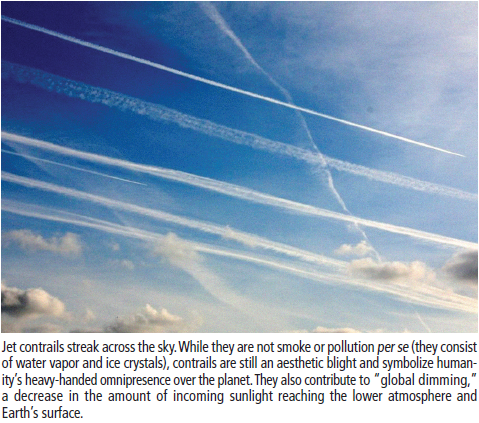 Since that article was published almost 35 years ago, the world’s population has swollen by an additional 3 billion humans and America’s by about 100 million new residents. And the beleaguered solitude and space I bemoaned have become ever-more menaced by the relentless tide of humanity and our long shadow. By our growing resource demands. By our far-reaching and intrusive noise. By our ubiquitous impacts on the Earth-enveloping atmosphere and climate. And last but not least, by the maddening crowds and traffic jams in our most beautiful, awe-inspiring natural areas, such as national parks.
Since that article was published almost 35 years ago, the world’s population has swollen by an additional 3 billion humans and America’s by about 100 million new residents. And the beleaguered solitude and space I bemoaned have become ever-more menaced by the relentless tide of humanity and our long shadow. By our growing resource demands. By our far-reaching and intrusive noise. By our ubiquitous impacts on the Earth-enveloping atmosphere and climate. And last but not least, by the maddening crowds and traffic jams in our most beautiful, awe-inspiring natural areas, such as national parks.
I have experienced firsthand the disruptive manmade noise and obnoxious crowding in some of America’s wildest and grandest places, including the very first wilderness area ever formally designated in the United States, the Gila Wilderness in southwestern New Mexico. Aldo Leopold himself, then working for the U.S. Forest Service, pushed for the Gila. It was set aside (legally protected) in 1924, a full four decades before the Wilderness Act passed Congress and was signed into law by President Johnson in 1964.
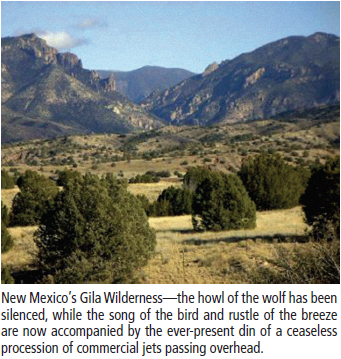 Backpacking through the Gila in 1989, I was appalled at the constant din of jet traffic overhead, and blue skies marred by persistent jet contrails. It may have been wilderness in name, but it wasn’t in reality anymore. In Leopold’s day half a century earlier, the silence and the expansive blue sky would not have been slashed and sliced by a steady succession of commercial jetliners.
Backpacking through the Gila in 1989, I was appalled at the constant din of jet traffic overhead, and blue skies marred by persistent jet contrails. It may have been wilderness in name, but it wasn’t in reality anymore. In Leopold’s day half a century earlier, the silence and the expansive blue sky would not have been slashed and sliced by a steady succession of commercial jetliners.
As soon as the noise from one jet passing overhead faded away, another began; they were almost perfectly synchronized to completely obliterate authentic silence, and a sense of majestic solitude, of being “away from” or beyond the reach of industrial civilization. This artificial noise injected into the natural setting wasn’t loud enough to drown out bird song or the whispering wind, but it was loud enough to be noticeable—and jarring, because this was “wilderness,” empty, vacant, “untrammeled,” devoid of manmade objects, and one of the most thinly populated places left in the continental USA. Yet mechanized man’s pervasive presence was overbearing even here.
In Leopold’s day, there were still wolves in this wilderness. Now, the howl of the wolf has been replaced with the incessant buzzing of jet traffic overhead. The price of progress?
My complaints aren’t just the lonely laments and rants of a cantankerous and wistful wilderness lover. Even the BBC is asking: “Is the world running out of space?” They reference the recent projections of the U.N. Population Division that, by 2030, global population will have grown to 8.4 billion from 7.3 billion today. Median projections foresee 9.7 billion humans on Earth by 2050 and more than 11 billion by 2100. Alarmingly, these recent projections are increases from the U.N.’s previous projections made several years ago. Earlier assumptions about future fertility declines in parts of the world have proved to be unduly optimistic.
Rachel Nuwer of the BBC points out that even today, without the massive continuing population increases projected for this century, it’s already difficult to get away from one another, to obtain a bit of reprieve or respite from Human Overload. Driving out of New York City into the Catskill Mountains, or out of San Francisco to Point Reyes National Seashore or Muir Woods, you’ll find the trails and beaches besieged with city-dwellers attempting the same Great Escape.
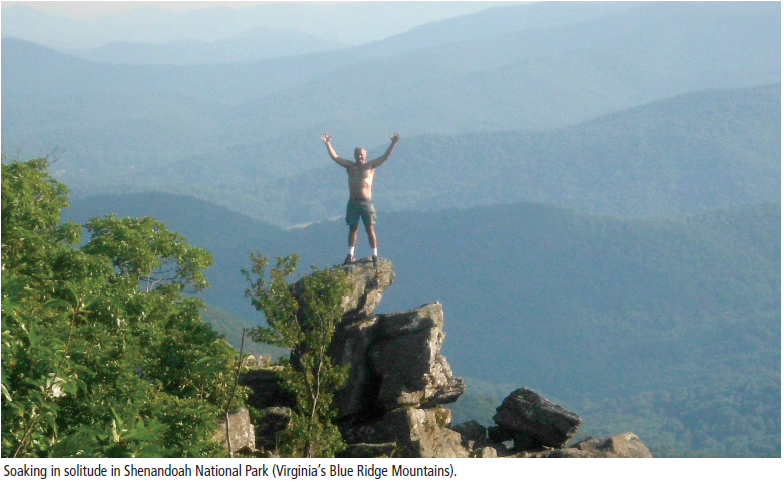 Skyline Drive in Virginia’s Shenandoah National Park of the Blue Ridge Mountains (part of the geologically ancient Appalachian Mountains) fills up with motorists—and their exhaust fumes—from Washington, D.C. and Fairfax County, especially on fall weekends when the autumn foliage lights up. Even the steep trail to the summit of Mt. Mansfield, at 4,398 ft. the highest point in Vermont and the Green Mountains, gets busy, to say nothing of trails in the Flatirons outside of Boulder, Colorado, or Piestewa Peak (formerly Squaw Peak) in Phoenix, Arizona.
Skyline Drive in Virginia’s Shenandoah National Park of the Blue Ridge Mountains (part of the geologically ancient Appalachian Mountains) fills up with motorists—and their exhaust fumes—from Washington, D.C. and Fairfax County, especially on fall weekends when the autumn foliage lights up. Even the steep trail to the summit of Mt. Mansfield, at 4,398 ft. the highest point in Vermont and the Green Mountains, gets busy, to say nothing of trails in the Flatirons outside of Boulder, Colorado, or Piestewa Peak (formerly Squaw Peak) in Phoenix, Arizona.
 In my first year living in Southern California, my wife and I committed the rookie error of trying to go camping in Joshua Tree National Monument on Thanksgiving weekend. I had naively thought that millions of minions would be visiting family nearby or watching Thanksgiving football classics at home.
In my first year living in Southern California, my wife and I committed the rookie error of trying to go camping in Joshua Tree National Monument on Thanksgiving weekend. I had naively thought that millions of minions would be visiting family nearby or watching Thanksgiving football classics at home.
After an hour stuck in gridlocked traffic on the eastbound Riverside Freeway (California State Route 91), with no end in sight, we threw in the towel, turned around and headed back to Santa Ana. I told myself that being stuck in traffic and breathing exhaust from tailpipes was no way to waste a precious holiday. That was the last time I ever tried to visit any national park or natural area in California on a holiday weekend.
According to Nuwer, “even more remote and supposedly idyllic spaces are feeling the crush, too.” Backcountry permits for Grand Teton National Park in Wyoming sell out months in advance, while Arches National Park in Utah had to shut down for several hours because of traffic gridlock in May earlier this year. Yosemite Valley in summertime? Don’t even go there. Disneyland is probably less crowded.
The very first time I tried to drive the celebrated Goingto-the-Sun Highway that traverses Glacier National Park in the Northern Rockies of Montana, I turned back when I saw the horrific, demoralizing amount of traffic stacked up at the park entrance. For those fortunate and rich enough to indulge themselves, escaping the human herd often means boarding a jet plane and flying off to increasingly far-flung and exotic sites, leaving a contrail and noise in their wake, to the everlasting annoyance of some zealot shaking his fist in the New Mexico wilds.
 Yet humanity’s bloated ecological footprint now reaches even the most remote places on Earth. There are nomadic herders in Mongolia’s Gobi desert, Berbers and Tuareg in the Sahara, and camps of scientists in the Arctic and Antarctica. Some years back, while I was living in Canada, I heard of a team of hardy explorers who were traversing Canada’s far northern taiga on foot and cross-country skis in a multi-month expedition. They observed what looked like a meteorite streak down to the ground. Going to investigate, they were irradiated by the radioactive fragments of a fallen satellite. There is truly no “getting away from it all” anymore.
Yet humanity’s bloated ecological footprint now reaches even the most remote places on Earth. There are nomadic herders in Mongolia’s Gobi desert, Berbers and Tuareg in the Sahara, and camps of scientists in the Arctic and Antarctica. Some years back, while I was living in Canada, I heard of a team of hardy explorers who were traversing Canada’s far northern taiga on foot and cross-country skis in a multi-month expedition. They observed what looked like a meteorite streak down to the ground. Going to investigate, they were irradiated by the radioactive fragments of a fallen satellite. There is truly no “getting away from it all” anymore.
 Antarctica, encompassing the South Pole at the bottom of the planet, is as far as away from the “madding crowd” as it is possible to be on Earth, yet even there, the crowd’s destructive excesses are in evidence. At the start of each spring, stratospheric ozone levels drop to dangerous levels, a result of the reckless abandon with which hundreds of millions of human beings released chlorofluorocarbons (CFCs) into the atmosphere for decades. (Thank goodness for the dedicated chemists and earth scientists who discovered this in time to prevent irreversible, catastrophic damage.)
Antarctica, encompassing the South Pole at the bottom of the planet, is as far as away from the “madding crowd” as it is possible to be on Earth, yet even there, the crowd’s destructive excesses are in evidence. At the start of each spring, stratospheric ozone levels drop to dangerous levels, a result of the reckless abandon with which hundreds of millions of human beings released chlorofluorocarbons (CFCs) into the atmosphere for decades. (Thank goodness for the dedicated chemists and earth scientists who discovered this in time to prevent irreversible, catastrophic damage.)
And now climatologists have demonstrated that even Antarctica—long perceived as an enduring, stable phenomenon practically as inviolate and isolated as another planet, and thus impervious to human folly—is beginning to melt and break up because of manmade global warming. In 2014, for example, two teams of scientists reported their findings on the incipient, irreversible collapse of the colossal Thwaites and other glaciers in West Antarctica. This collapse and melting alone will raise sea level by four feet in the coming centuries, over and above other predicted sea level rise.
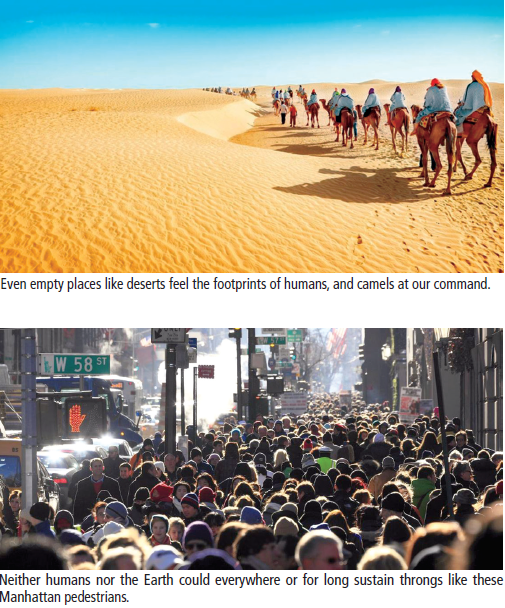 Australian Geographic says that even remote, isolated Anarctica is “at risk from [a] flood of people,” that everincreasing numbers of visitors combined with poor management threaten the viability of this extreme but fragile ecosystem. The number of visitors to the icy continent has quadrupled in the new century.
Australian Geographic says that even remote, isolated Anarctica is “at risk from [a] flood of people,” that everincreasing numbers of visitors combined with poor management threaten the viability of this extreme but fragile ecosystem. The number of visitors to the icy continent has quadrupled in the new century.
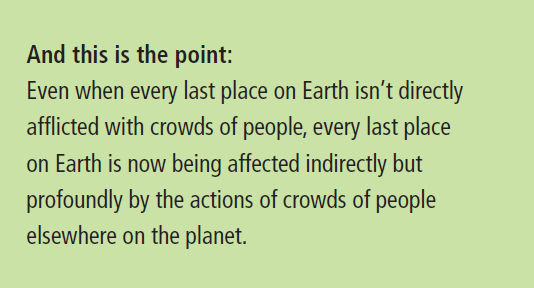 All visitors to Antarctica are either scientists or eco-tourists—not loggers, miners or poachers. They come to study the environment and appreciate it, not to exploit it, so it is ironic, to say the least (but not at all surprising to a population ecologist), that increasing numbers should pose a potential threat to the icy continent and its few iconic inhabitants, such as penguins. Diseases introduced to wildlife, oil spills and untreated sewage are examples of the kinds of threats that more people inadvertently exacerbate. It truly is possible to “love a place to death.”
All visitors to Antarctica are either scientists or eco-tourists—not loggers, miners or poachers. They come to study the environment and appreciate it, not to exploit it, so it is ironic, to say the least (but not at all surprising to a population ecologist), that increasing numbers should pose a potential threat to the icy continent and its few iconic inhabitants, such as penguins. Diseases introduced to wildlife, oil spills and untreated sewage are examples of the kinds of threats that more people inadvertently exacerbate. It truly is possible to “love a place to death.”
Either Mother Earth isn’t big enough for us, or we’re too big for our britches and for Mother Earth. It’s time to trim our numbers and dampen our demands before we kill the goose that laid the golden egg.




